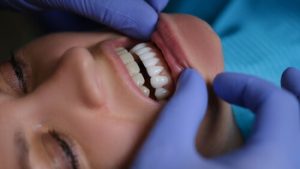Have you ever noticed chalky white spots on your teeth or your child’s teeth and wondered what they mean? These marks might seem harmless at first glance, but they can actually be an early sign of tooth decay. In this guide, we’ll unpack everything you need to know about tooth decay, white spots on teeth, what causes them, how to prevent them, and the treatment options available. Whether you’re caring for adult teeth or children’s teeth, early awareness is key.
What Are These Mysterious White Spots?
White spots on teeth typically appear as small, chalky patches on the tooth surface, often near the gum line or in areas that are harder to clean. They might be dull or bright white and can affect one or several teeth. While they may look like cosmetic concerns, these marks are often a red flag for early tooth decay.
They occur when the tooth enamel, the hard outer layer of your tooth, begins to lose essential minerals, a process known as enamel demineralisation. Left untreated, this early stage of decay can progress to cavities and gum disease and even require root canal therapy in severe cases.
What Causes White Spots on Teeth?
Let’s explore some common causes behind these unwanted marks:
1. Poor Oral Hygiene
Neglecting your oral health is one of the biggest culprits. When you don’t brush and floss regularly, plaque buildup occurs. Plaque contains harmful bacteria that feed on sugars and produce acid, which weakens the enamel. Over time, this results in mineral loss from the tooth’s enamel, leaving behind white or chalky spots.
2. Diet High in Sugar or Acid
Soft drinks, lollies, and acidic foods create the perfect environment for decay-causing bacteria. The more frequently these are consumed, the higher the risk of early decay and enamel demineralisation.
3. Too Much Fluoride Exposure
Fluoride is essential for strong teeth, but excess fluoride exposure can lead to dental fluorosis in children. This condition causes white streaks or spots on teeth, especially during the development of permanent teeth. It often occurs from swallowing toothpaste, taking fluoride supplements unnecessarily, or drinking bottled water with unknown fluoride levels.
4. Enamel Hypoplasia
This condition causes thinner or weaker enamel due to health conditions, certain medications, or even nutritional deficiencies during childhood. It often results in white or brownish tooth discolouration, increasing the risk of decay.
5. Orthodontic Treatment
Wearing braces can make it harder to maintain proper oral hygiene, especially around brackets. Plaque can accumulate easily in these areas, leading to white spots on teeth if not cleaned thoroughly.
6. Dry Mouth or Low Saliva Flow
Saliva plays a crucial role in neutralising acids and aiding remineralisation of enamel. A dry mouth, whether due to medications or medical conditions, limits saliva flow, reducing your mouth’s natural defence mechanism.
Are White Spots Always a Sign of Decay?
Not necessarily. Some white spots on teeth are purely cosmetic and might not indicate tooth decay. However, distinguishing between harmless marks and early decay is not always straightforward. That’s why regular dental checkups are essential. A dentist can assess the underlying cause, keep track of any changes, and create a treatment plan to support your oral health.
Why Early Detection Matters
Catching the early stages of decay can make all the difference. At this point, tooth enamel can often be remineralised without the need for drilling or fillings. But if ignored, these chalky spots can worsen, creating deeper cavities and infections that require root canal therapy or even extraction.
How to Prevent Tooth Decay White Spots
The best way to deal with white spots is to stop them before they start. Here’s how:
 1. Practise Proper Oral Hygiene
1. Practise Proper Oral Hygiene
- Brush twice a day using fluoride toothpaste
- Floss daily to remove plaque between teeth
- Rinse with a fluoride mouthwash or fluoride gel if advised by your dentist
2. Visit Your Dentist Regularly
Routine dental visits allow your dentist to detect signs of decay early and advise on prevention or treatment. Regular dental checkups are vital for both adults and children.
3. Use Fluoride Wisely
Fluoride strengthens enamel, but moderation is key:
- Use only a pea-sized amount of toothpaste for children
- Encourage children to spit, not swallow, toothpaste
- Only use fluoride supplements if prescribed by a dentist
4. Maintain a Balanced Diet
Limit sugar and acid intake, and choose water as your main drink. Drinking water regularly (especially if fluoridated) also helps rinse away food particles and bacteria.
5. Watch for Early Warning Signs
Keep an eye on your teeth for any changes in colour or texture. If you notice white spots, especially in kids, book a checkup.
Treatment Options for White Spots on Teeth
Once white spots on teeth appear, your dentist will assess the cause and recommend the most suitable treatment options. These might include:
1. Remineralisation Therapy
This involves using fluoride treatments, fluoride gel, or specially formulated products like calcium phosphate pastes to help replenish lost minerals in the enamel.
2. Teeth Whitening
If the spots are purely cosmetic and not caused by active decay, teeth whitening can help reduce their appearance by blending the colour of your teeth. However, this should only be done after a full assessment, as whitening won’t help if the spots are due to active decay.
3. Microabrasion
This minimally invasive procedure removes a very thin layer of the enamel to reduce or eliminate white spots. It’s often used in combination with whitening for the best results.
4. Composite Bonding
For more noticeable tooth discolouration, dental bonding can be applied to cover the spots and restore a more uniform appearance.
5. Porcelain Veneers
In severe cases where spots are widespread or deeply embedded, veneers can offer a longer-term cosmetic solution. They cover the entire front surface of the tooth, masking imperfections effectively.
Children’s Teeth: Extra Care for Little Smiles
Children are more prone to white spots due to developing teeth and sometimes inconsistent brushing habits. Helping them maintain proper oral hygiene from an early age can make a significant difference. Tips include:
- Supervising tooth brushing until at least age 8
- Using child-appropriate fluoride toothpaste
- Avoiding excessive fluoride exposure
- Ensuring a healthy diet low in sugar
- Scheduling regular dental checkups from the appearance of their first tooth
When to See a Dentist

- Assess whether it’s early decay, dental fluorosis, or something else
- Recommend a personalised treatment plan
- Provide advice on improving oral hygiene
- Possibly recommend X-rays if further investigation is needed
Final Thoughts: Don’t Ignore the Chalky Spots
Tooth decay white spots on teeth may seem like a small issue, but they are often a warning sign that your oral health needs attention. With good habits, routine dental visits, and the right advice, many cases can be reversed or treated easily.
By being proactive and maintaining good oral hygiene, you’re not just protecting your teeth; you’re investing in a healthy smile for life.
If you’ve noticed white spots or have concerns about your oral health, contact Advanced Dental Care Dubbo today at (02) 6188 7103 to schedule a checkup and get personalised advice that suits your needs.
References
- Cleveland Clinic. (n.d.). Enamel hypoplasia. Retrieved from https://my.clevelandclinic.org/health/diseases/enamel-hypoplasia
- Healthline. (n.d.). Dental veneers: Pros, cons, costs, and more. Retrieved from https://www.healthline.com/health/dental-veneers
- WebMD. (n.d.). Tooth enamel: Erosion and restoration. Retrieved from https://www.webmd.com/oral-health/tooth-enamel-erosion-restoration



 1. Practise Proper Oral Hygiene
1. Practise Proper Oral Hygiene




